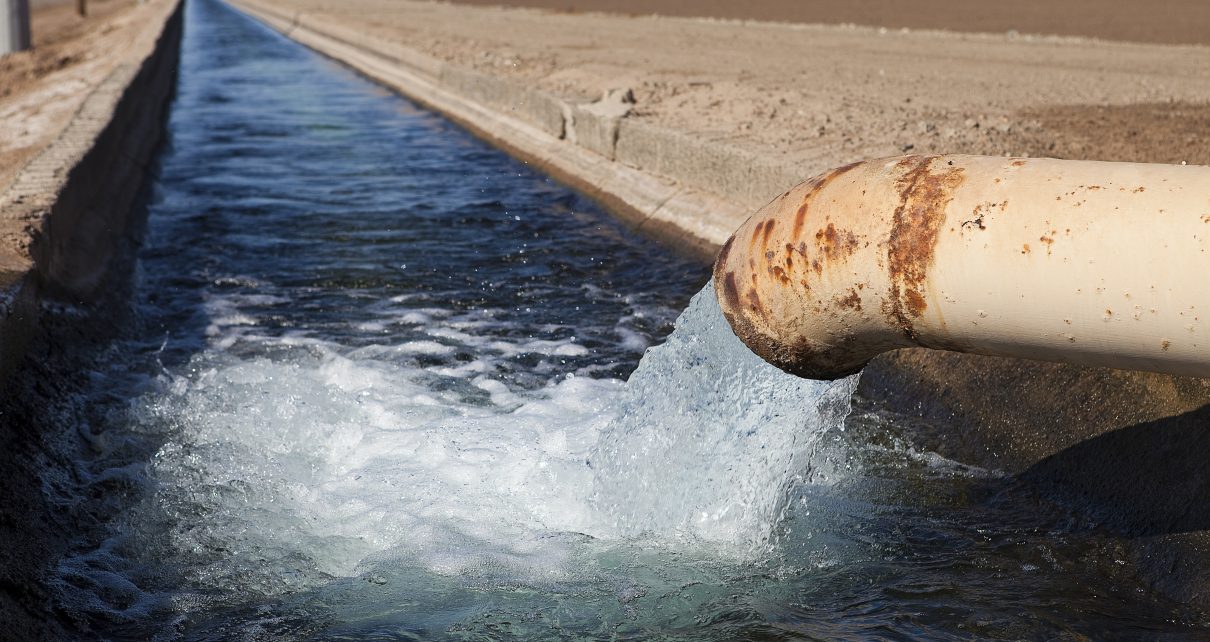
An irrigation canal pumping water. (Photo: Straight 8 Photography/Shutterstock)
The Abundance Choice, Part 10: Time to Stop Wasting Wastewater
Every year this torrent of mostly treated effluent is equivalent in volume to the San Joaquin river in a wet year
By Edward Ring, June 3, 2022 2:30 am
If there is any source of water that ought to be optimized, it is the wastewater produced by California’s urban centers. Perennially issuing from sewage treatment plants throughout the state, every year this torrent of mostly treated effluent is equivalent in volume to the San Joaquin River in a wet year.
The California Department of Water Resources estimates statewide urban water consumption at approximately seven million acre feet per year. Just over three million of that total is estimated to be so-called “interior” water use, which means this water is flushed or drained through sewer systems into a wastewater treatment plant. In most cases, after being treated, this water is discharged into California’s rivers or emptied directly into the Pacific Ocean.
But there is an opportunity to do much more. Insufficiently treated wastewater being discharged into the Sacramento Delta and its tributaries have resulted in a buildup of excess nitrogen and other pollutants, harming these ecosystems. This same problem is playing out along the Southern California coast, where millions of acre feet of imported water is used once, insufficiently treated, and dumped into the Pacific.
In all of these cases, this water could be put to beneficial use. If California’s inland cities were to treat their wastewater to higher standards, even if it were still just released into the San Francisco Bay, or the Sacramento / San Joaquin Delta or its tributaries, it would increase California’s water supply, because it would reduce the need to maintain higher natural flows merely to dilute and to flush nitrogen and other pollutants out of the Delta and the San Francisco Bay. Hence more water could be withdrawn for immediate use or stored for subsequent use including fulfilling other environmental proposes.
For example, north of the Delta, the Sacramento Regional County Sanitation District’s recently completed wastewater treatment upgrades now remove 99 percent of ammonia (a source of nitrogen) from wastewater. This means that 150 million gallons per day – or 168,000 acre feet per year – is now released into the Sacramento River while causing almost no harm to the downstream ecosystems. The district now intends to upgrade the system to inject some of this water directly into aquifers to serve agricultural clients. This level of treatment should be adopted by every one of California’s inland urban water districts.
California’s coastal cities that import water from the State Water Project face a different challenge. There is no downstream use for their wastewater. Their opportunity is to treat this water, ideally, up to potable reuse standards, and therefore use their wastewater over and over again. The benefit of wastewater reuse is especially evident in Southern California, because of the tremendous energy expenditure required to pump water from distant sources over the mountains into the south coast cities, and also because of the sheer scale of these water transfers.
The megapolis on California’s southern coast stretches from Ventura County on the northern end, through Los Angeles County, Orange County, down to San Diego County on the border with Mexico. It also includes the western portions of Riverside and San Bernardino counties. Altogether these six counties have a population of 20.5 million residents. According to the California Department of Water Resources, urban users in these counties consume 3.7 million acre feet of water per year, while agricultural users consume an additional 700,000 acre feet.
Most of this water is imported. In an average year, 2.6 million acre feet of water is imported by the water districts serving the residents and businesses in these Southland counties. The 701 mile long California Aqueduct, mainly conveying water from the Sacramento River, contributes 1.4 million acre feet. The 242 mile long Colorado River Aqueduct adds another 1.0 million acre feet. Finally, the Owens River on the east side of the Sierras contributes 250,000 acre feet via the 419 mile long Los Angeles Aqueduct. All of these deliveries are being cut back this year due to the ongoing drought, and the future reliability of water deliveries in these historic quantities is very uncertain.
Energy to Treat vs. Energy to Transport
The energy to treat and deliver wastewater on-site in Southern California is offset by the energy no longer required to transport that same amount of water through, for example, the California Aqueduct. Calculating how much energy the pumps consume along the California aqueduct is therefore a useful benchmark against which to compare the energy efficiency of wastewater reuse.
Water pumped from the Sacramento Delta to the Los Angeles Basin through the California Aqueduct requires 3.45 megawatt-hours per acre foot. That’s not a trivial amount of energy, because it’s not a trivial achievement to move millions of acre feet of water several hundred miles, periodically lifting all of that water via six power hungry pumping stations a combined total of 3,251 feet. The following chart, using data from the California Dept. of Water and Power, presents the numbers underlying this epic accomplishment. The centerpiece of the project is the Edmonston Pumping Plant, which gives the water its final gargantuan push of nearly 2,000 feet over the Tehachapi Pass into Los Angeles. When running at capacity, the Edmonston Pumping Plant draws 776 megawatts, with each of its 14 massive pumps generating power equivalent to eight modern locomotives.
According to this data, if the last link in the chain, the Edmonston Pumping Plant, operated at maximum capacity for an entire year, it could deliver 3.2 million acre feet of water over the mountains into Los Angeles. Taking into account the power requirements of all six pumping stations, delivering 1.0 million acre feet would require a continuous 393 megawatt current for a year. Keeping in mind that the head pressure the water develops on the other side of the Tehachapi Pass within the pipes that descend into the Los Angeles Basin eliminates any need for subsequent pumping, this amount – 3,448 gigawatt-hours per million acre feet, or 0.393 gigawatt-years – is the primary variable to consider when comparing the energy required for Los Angeles to get water from the California Aqueduct versus other water supply project options.
Recycling Water in Southern California
A lot of wastewater is already recycled in Southern California. In 2020, water agencies from Ventura to San Diego counties recycled 455,000 acre feet per year of wastewater, an amount that has nearly tripled since 2000. Orange County Water District, serving 2.5 million residents, now treats 100 percent of its wastewater for “indirect potable reuse.” This means that after treatment, the wastewater is injected into local aquifers, to then be pumped up and reused as potable water.
Orange County’s “Groundwater Replenishment System” is the world’s largest water purification system for indirect potable reuse. As noted on their website, “The system takes highly treated wastewater that would have previously been discharged into the Pacific Ocean and purifies it using a three-step advanced treatment process consisting of microfiltration, reverse osmosis and ultraviolet light with hydrogen peroxide. The process produces high-quality water that meets or exceeds all state and federal drinking water standards.”
Orange County’s Groundwater Replenishment System Final Expansion (GWRSFE) project, which will be completed later this year, will increase treatment capacity from 103,000 acre feet to 134,000 acre feet per year. The treated water is pumped into local aquifers.
Orange County’s comprehensive wastewater reuse capacity was facilitated by two favorable factors. First, they were able to situate the treatment plant right next to the Orange County Sanitation District’s primary treatment plant, and second, because only a few miles from the treatment plant, there are capacious, uncontaminated aquifers that Orange County has already been using to store their drinking water. This makes the total project cost for the 134,000 acre foot annual yield from their treatment plant under $1.5 billion even when including cost for conveyances and funds from the Sanitation District, i.e., around $11,200 per acre foot.
This suggests ratepayers can finance much of the cost for recycled water, because according to sources at OCWD, the fully loaded unit cost, including operating expenses and amortization of the capital cost, is $704 per acre foot. To help put this in perspective, the Los Angeles based Metropolitan Water Authority (often referred to as “Met”), a massive cooperative of fourteen cities, eleven municipal water districts, and one county water authority, that provides water to 19 million people in a 5,200-square-mile (13,000 km2) service area, in January 2022 was charging its clients $1,143 per acre foot of treated water. During the last drought between 2012-2016, “some farmers paid up to $2,200 per acre foot to water high value crops.”
Taking into account these economics, Met is also preparing to make massive investments in wastewater recycling. With construction planned to begin in 2024, Met intends to invest $3.4 billion to build a wastewater recycling plant in the City of Carson, about 16 miles south of downtown Los Angeles. The plant is designed to have a projected capacity of 168,000 acre feet per year, and its output will also be treated to indirect potable reuse standards. The treated water will be delivered through an extensive network of new pipelines to injection wells in four groundwater storage basins spread across Los Angeles County and into Orange County. Taking into account the cost to build the plant and the pipelines, plus annual operating costs of $129 million, Met estimates the water will cost $1,830 per acre foot.
Energy Required to Treat and Deliver Urban Wastewater
The power requirements to reuse wastewater vary significantly. Much this difference arises because every treatment site has different requirements for accessing the wastewater feedstock and delivering the treated water. In Orange County, the plant that treats the water to indirect potable standards is close to the original wastewater treatment plant, so accessing that water requires minimal pipes and pumping. Also working in their favor are the groundwater basins which are also close to the pumping plant. In Los Angeles, by contrast, where up to 60 miles of pipes are planned to deliver water from the Carson treatment plant to five aquifers spread all over the county and even into one in Orange County, far more power is required. According to engineers working at GWRS, Orange County’s water reuse system requires 0.35 megawatt-hours to deliver one acre foot of treated water to storage aquifers. According to engineers at Met, the system proposed for Los Angeles will require 0.94 megawatt-hours to deliver one acre foot of treated water to storage aquifers.
The projected MWH requirement for treatment at the proposed Carson facility, 1.56 megawatt-hours per acre foot, is 50 percent greater than what is required, 1.05 megawatt-hours per acre foot, for treatment in Orange County. It is not clear why Met’s projected power requirement for treatment is so much higher than in Orange County, but these numbers were carefully sourced from engineers familiar with both projects. Informed suggestions to explain the difference are that Orange county may have better source control to pretreat wastewater, Los Angeles has a higher percentage of industrial wastewater which requires more treatment, and that Los Angeles may be intending to treat their wastewater to a higher standard in anticipation of using the Carson plant for direct potable reuse (DPR). This last possibility is intriguing, because next year the state will finalize DPR standards. If the Carson plant were constructed to DPR standards, they would be able to deliver reused wastewater directly to the taps of residential consumers, avoiding the energy costs to transport the water to aquifers and then pump that water back out again for final distribution.
Because of the many variables involved, a serious examination of the energy required for wastewater reuse throughout California goes beyond the scope of this report, but it is nonetheless reasonable to assume that the amount of electric power per acre foot required to treat wastewater in Orange County to IPR standards is on the low end of the range, and the estimate for treatment in the proposed Los Angeles plant is on the high end of the range. And by establishing this range of power requirements, we can still make some useful observations.
The Cost to Build Statewide Urban Wastewater Recycling Plants
A recent and highly publicized study by the Pacific Institute claims that in California the “reuse potential of municipal wastewater is 1.8 million to 2.1 million acre feet” per year. Based on the costs incurred in Orange County and the projected costs in Los Angeles county, a credible estimate of the capital cost per acre foot of water recycling capacity would be $15,000 per acre foot. This suggests that building the new treatment plants to recycle 2.0 million acre feet of urban wastewater could cost up to $30 billion.
Under these assumptions, the capital cost amortized over 20 years at an interest rate of 5 percent yields an annual payment of $1,204 per acre foot of output. While the feedstock – wastewater – is free, along with paying down the construction cost, the price of recycled wastewater also has to take into account energy and other operating costs.
What these estimates definitely reveal is, again, the need for money from the state general fund to subsidize a major portion of the capital cost for water recycling plants. This takes the burden off of the local ratepayers while improving the overall resiliency of California’s water supply.
One big change coming very soon is the transition from indirect potable reuse to direct potable reuse. California’s Dept. of Water Resources is tasked by the state legislature to come up with final regulations to govern direct potable reuse (DPR) by 2023. Because DPR involves pumping recycled wastewater directly into a public water system, the standards and safeguards are necessarily more stringent than those for indirect potable reuse, where the presence of an aquifer serves as buffer that offers some response time in the event of a “process failure.” Nonetheless, DPR has already been implemented in Texas, standards have already been approved in Arizona, and other states including Colorado and Florida have joined California to begin developing standards.
California’s imminent approval of direct potable reuse standards for wastewater will open up possibilities in counties where the topography, a dense built-out urban environment, the location of existing water infrastructure, the location and viability of storage aquifers or surface reservoirs, do not favor a cost effective indirect potable reuse solution.
One of the virtues of urban wastewater recycling is that there is less opposition to these projects. Because wastewater recycling can only reuse interior water, and because only between 75 and 85 percent of wastewater can be reused, it is only part of the solution to urban water supply challenges in California. But reusing up to two million acre feet per year would be a terrific accomplishment, and even in Los Angeles where the reused water will be pumped through many miles of pipes, the energy used to deliver that water is less than the energy necessary to transport the water into Los Angeles via the California Aqueduct.
Even if political paralysis may prevent implementation of other solutions to water scarcity, California’s state legislature should massively fund the efforts of water agencies throughout the state to reuse 100 percent of their wastewater.
- Ringside: Will the Delta Pumps Operate at Capacity this Winter? - December 18, 2025
- Ringside: Will Advocates for More Water Supply Projects Find Unity? - December 11, 2025
- Ringside: EVs and California’s Future Demand for Electricity - December 4, 2025

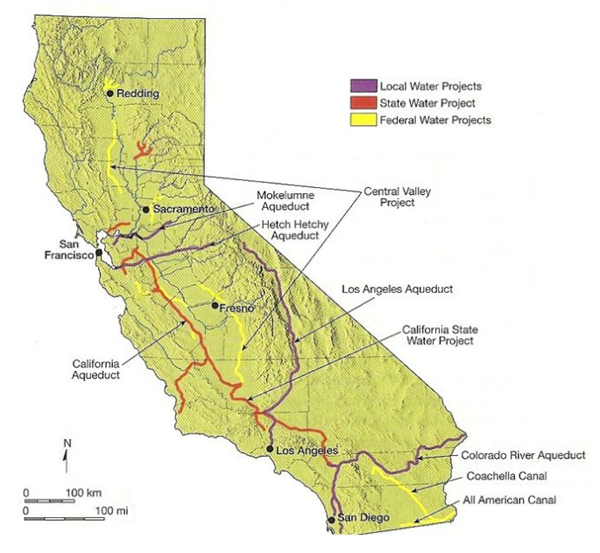
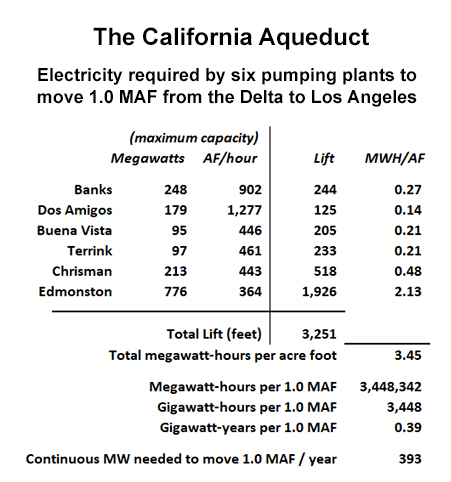
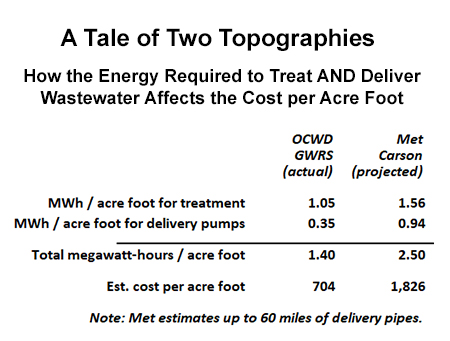


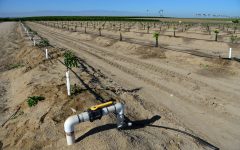

Or we could just build the damn dams that we were supposed to with the bonds that were passed several years ago, so we would NOT have to rely on “toilet to tap” water described so eloquently here…
California legislators would rather have us drink, bathe and cook with our own processed effluent, than build the reservoirs to capture the fresh rainwater that our “Pineapple Express” deluges deliver every few years….
Sickening….
STOP VOTING FOR SICKENING DEMOCRATS who are beholden to sickening “environmentalists”…
Care to explain why DPR water is such a bad thing? Because the way we see it, this technology comes with a lot of pros that could make life much easier for people without it hurting the environment. Why do Republicans focus more on short-term self-gratification over long-term solutions?
I’m not sure Republicans are against DPR water. Name a Republican elected official who opposes DPR water.